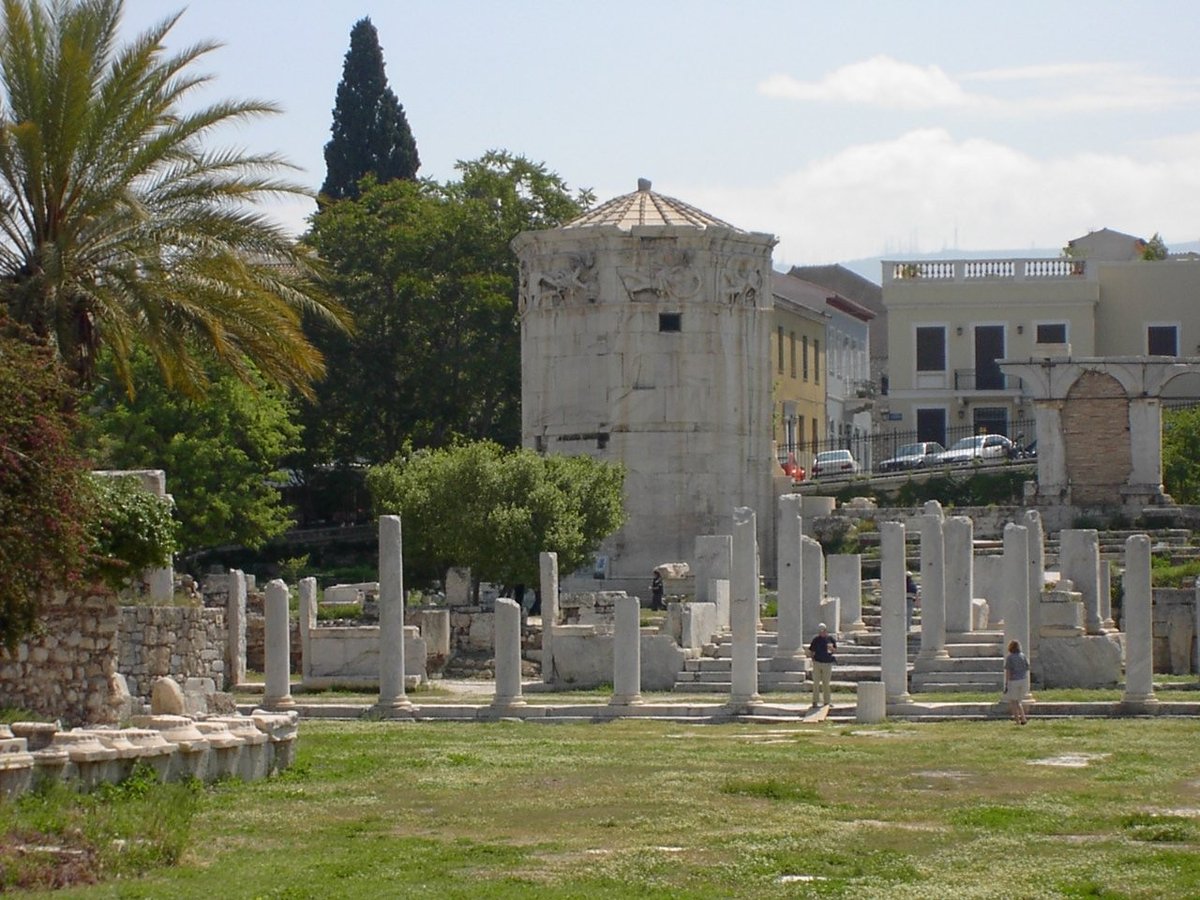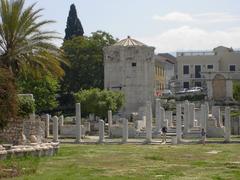
Tower of the Winds Athens: Visiting Hours, Tickets, and Complete Historical Site Guide
Date: 14/06/2025
Introduction
The Tower of the Winds in Athens is a unique monument that seamlessly blends ancient science, art, and civic life. Constructed around the 1st century BCE, it stands as one of the world’s earliest meteorological stations and public clock towers. This comprehensive guide explores the Tower’s remarkable history, architectural innovation, and scientific significance, alongside practical details for visitors—such as opening hours, tickets, accessibility, and travel tips. Whether you are a history enthusiast, architecture admirer, or curious traveler, the Tower of the Winds offers an extraordinary window into Athens’ rich heritage.
For the latest updates, official information, and resources, consult the Greek Ministry of Culture, the Official Tower of the Winds website, Greeka, and Rough Guides.
Table of Contents
- Introduction
- Origins and Construction
- Architectural and Scientific Innovations
- Historical Transformations
- Visiting Information
- Architectural Legacy and Global Influence
- Travel Tips and Nearby Attractions
- Frequently Asked Questions (FAQ)
- Conclusion
- References
Origins and Construction
The Tower of the Winds, also known as the Horologion of Andronicus or Ωρολόγιο του Κυρρήστου, was constructed between 100–50 BCE by the astronomer Andronicus of Cyrrhus. Built from Pentelic marble, the structure stands approximately 12–13.5 meters tall and 8 meters in diameter. Its octagonal form aligns each side with a principal wind direction, serving both as a timekeeping device and meteorological observatory (Greeka).
Strategically located in the Roman Agora, the Tower was central to the daily rhythms of ancient Athens, providing vital information to merchants, sailors, and citizens. The innovative design drew from both scientific principles and artistic traditions, making it a focal point of civic life.
Architectural and Scientific Innovations
Octagonal Structure and Reliefs
Each of the eight sides is dedicated to a wind deity (Anemoi): Boreas (N), Kaikias (NE), Apeliotes (E), Eurus (SE), Notus (S), Lips (SW), Zephyrus (W), and Skiron (NW). High-relief sculptures of these deities are carved into the upper section, visually representing the winds that influenced daily life (Greeka). Above the frieze, the original bronze Triton weather vane indicated wind direction (Tower of the Winds).
Sundials and Water Clock (Clepsydra)
The Tower features eight sundials, one on each exterior face, allowing Athenians to determine the time throughout the day. Inside, a sophisticated water clock, powered by water from the Acropolis, ensured timekeeping even at night or during cloudy weather. This clepsydra was an advanced mechanism for its era, capable of displaying the hour year-round with notable accuracy (Tower of the Winds; Water Clock Study PDF).
Meteorological Function
The combination of the wind vane, sundials, and water clock made the Tower the world’s earliest known meteorological station and a public clock tower accessible to all citizens (Tower of the Winds).
Historical Transformations
Late Antiquity and Byzantine Period
In late antiquity, the Tower was converted into a Christian martyrium, with religious paintings and crosses indicating its new function. Its timekeeping role faded as the surrounding area became a cemetery.
Ottoman Era
During Ottoman rule, the Tower became a tekke for Sufi dervishes, incorporating features like a mihrab and additional windows. The dervishes’ presence helped preserve the monument, preventing its dismantling (Rough Guides).
Rediscovery and Modern Preservation
European travelers in the 18th and 19th centuries documented the Tower, sparking neoclassical interest. Restoration efforts by the Archaeological Society of Athens and the Greek Ministry of Culture have ensured its preservation for modern visitors (PromptGuides).
Visiting Information
Location
The Tower of the Winds is located in the Roman Agora, near the intersection of Aiolou and Diogenous streets in the Monastiraki district (PromptGuides).
Opening Hours
- April to October: 8:00 AM – 8:00 PM
- November to March: 8:00 AM – 5:00 PM
Check official sources for seasonal updates or special closures (Official Tower of the Winds website).
Tickets
- Adults: ~€10 (Roman Agora ticket, includes the Tower)
- Reduced: €5 (EU citizens 18–25)
- Free: EU citizens under 18 and over 65, students, and some other categories
Tickets can be purchased onsite or online via the Greek Ministry of Culture.
Accessibility
The Roman Agora is generally accessible, but the Tower’s interior is not wheelchair-friendly due to its ancient structure. Check with the site for updated accessibility information.
Guided Tours and Events
Many guided tours of the Roman Agora include the Tower of the Winds. Occasionally, special cultural events and educational programs are held nearby (Rough Guides).
Architectural Legacy and Global Influence
Influence on Later Architecture
The Tower’s design has inspired numerous structures, especially during the Greek Revival and Neoclassical movements:
- Radcliffe Observatory, Oxford: Modeled directly after the Tower (Greece Insiders).
- Vagliano Tomb, London and Torre del Marzocco, Livorno: Both draw on the Tower’s octagonal form (Greek News Agenda).
- Modern Echoes: Toyo Ito’s Tower of Winds in Yokohama, Japan, reinterprets its fusion of art and environmental data (Parametric Architecture).
Enduring Symbolism
The Tower exemplifies the integration of science and art, serving as a model for scientific architecture and public timekeeping. Its reliefs, sundials, and hydraulic clock influenced the development of observatories and civic buildings worldwide (Acropolis Greece).
Travel Tips and Nearby Attractions
- Combine your visit with the Acropolis, Ancient Agora, and Hadrian’s Library.
- Arrive early or late to enjoy fewer crowds and better photography light.
- Monastiraki metro station is the closest public transport stop.
For a richer experience, explore virtual tours and photo galleries on official Athens tourism websites.
Frequently Asked Questions (FAQ)
Q: What are the Tower of the Winds’ opening hours?
A: 8:00 AM–8:00 PM (April–October), 8:00 AM–5:00 PM (November–March); check for updates.
Q: How much are tickets?
A: Included in the Roman Agora ticket (~€10 for adults, reduced/free options available).
Q: Is the site accessible?
A: The Roman Agora is mostly accessible, but the Tower’s interior has limited access due to its ancient design.
Q: Are guided tours available?
A: Yes, through official and private providers.
Q: Can I take photos?
A: Yes, but flash and tripods may be restricted.
Conclusion
The Tower of the Winds is a singular monument that encapsulates the ingenuity and spirit of ancient Athens, bridging science, architecture, and civic identity. Its innovative design—incorporating sundials, a hydraulic water clock, and a wind vane—marks it as a pioneering example of scientific architecture and public timekeeping. Over centuries, the Tower has adapted to shifting cultural landscapes, enriching its narrative as a symbol of Athens’ dynamic past.
Plan your visit by considering seasonal hours, ticketing, and guided tours. For further details and travel resources, consult the Greek Ministry of Culture, Official Tower of the Winds website, Greeka, and Rough Guides. Immerse yourself in the legacy of ancient Greek innovation and the evolving story of Athens by visiting this iconic site.
References and Further Reading
- Tower of the Winds in Athens: History, Visiting Hours, Tickets & Guide to One of Athens’ Most Famous Historical Sites, 2025, Greek Ministry of Culture
- Tower of the Winds Visiting Hours, Tickets, and Historical Significance in Athens, 2025, Greeka
- Tower of the Winds Visiting Hours, Tickets, and Guide to Athens’ Historic Roman Agora Site, 2025, Rough Guides
- Visiting the Tower of the Winds in Athens: History, Hours, Tickets, and Architectural Legacy, 2025, Greek News Agenda
- Tower of the Winds official website, 2025, Official Tower of the Winds website
- Water Clock Study PDF, Antikythera Documentation
- Oxford Handbook of Engineering and Technology in the Classical World, 2008, Google Books




















































































